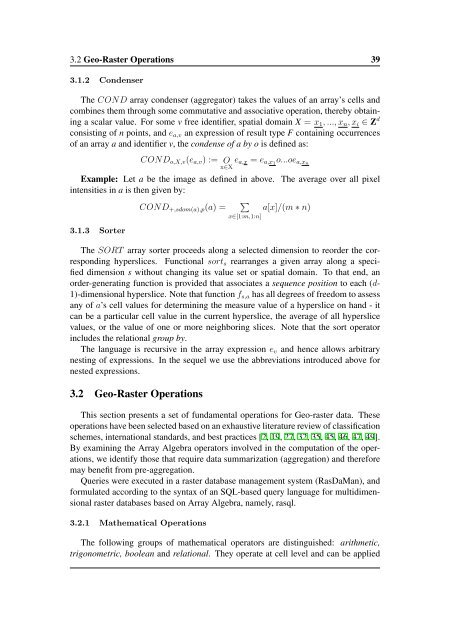Applying OLAP Pre-Aggregation Techniques to ... - Jacobs University
Applying OLAP Pre-Aggregation Techniques to ... - Jacobs University
Applying OLAP Pre-Aggregation Techniques to ... - Jacobs University
You also want an ePaper? Increase the reach of your titles
YUMPU automatically turns print PDFs into web optimized ePapers that Google loves.
3.2 Geo-Raster Operations 39<br />
3.1.2 Condenser<br />
The COND array condenser (aggrega<strong>to</strong>r) takes the values of an array’s cells and<br />
combines them through some commutative and associative operation, thereby obtaining<br />
a scalar value. For some v free identifier, spatial domain X = x 1 , ..., x n , x i ∈ Z d<br />
consisting of n points, and e a,v an expression of result type F containing occurrences<br />
of an array a and identifier v, the condense of a by o is defined as:<br />
COND o,X,v (e a,v ) := O<br />
x∈X<br />
e a,x = e a,x1 o...oe a,xn<br />
Example: Let a be the image as defined in above. The average over all pixel<br />
intensities in a is then given by:<br />
∑<br />
COND +,sdom(a),p (a) = a[x]/(m ∗ n)<br />
3.1.3 Sorter<br />
x∈[1:m,1:n]<br />
The SORT array sorter proceeds along a selected dimension <strong>to</strong> reorder the corresponding<br />
hyperslices. Functional sort s rearranges a given array along a specified<br />
dimension s without changing its value set or spatial domain. To that end, an<br />
order-generating function is provided that associates a sequence position <strong>to</strong> each (d-<br />
1)-dimensional hyperslice. Note that function f s,a has all degrees of freedom <strong>to</strong> assess<br />
any of a’s cell values for determining the measure value of a hyperslice on hand - it<br />
can be a particular cell value in the current hyperslice, the average of all hyperslice<br />
values, or the value of one or more neighboring slices. Note that the sort opera<strong>to</strong>r<br />
includes the relational group by.<br />
The language is recursive in the array expression e v and hence allows arbitrary<br />
nesting of expressions. In the sequel we use the abbreviations introduced above for<br />
nested expressions.<br />
3.2 Geo-Raster Operations<br />
This section presents a set of fundamental operations for Geo-raster data. These<br />
operations have been selected based on an exhaustive literature review of classification<br />
schemes, international standards, and best practices [2, 19, 27, 32, 35, 45, 46, 47, 49].<br />
By examining the Array Algebra opera<strong>to</strong>rs involved in the computation of the operations,<br />
we identify those that require data summarization (aggregation) and therefore<br />
may benefit from pre-aggregation.<br />
Queries were executed in a raster database management system (RasDaMan), and<br />
formulated according <strong>to</strong> the syntax of an SQL-based query language for multidimensional<br />
raster databases based on Array Algebra, namely, rasql.<br />
3.2.1 Mathematical Operations<br />
The following groups of mathematical opera<strong>to</strong>rs are distinguished: arithmetic,<br />
trigonometric, boolean and relational. They operate at cell level and can be applied
















